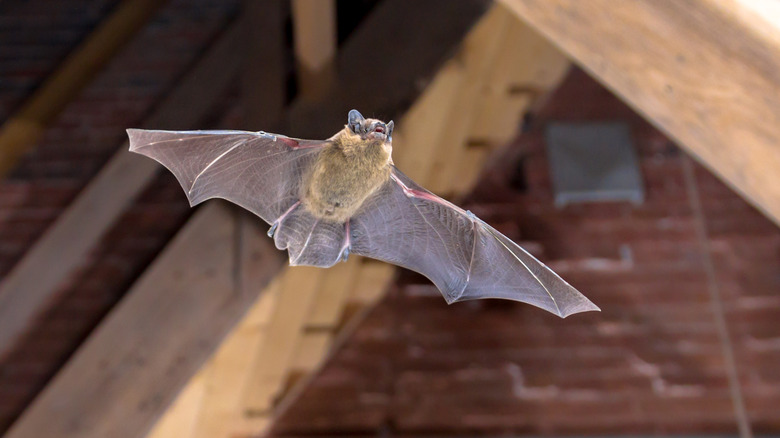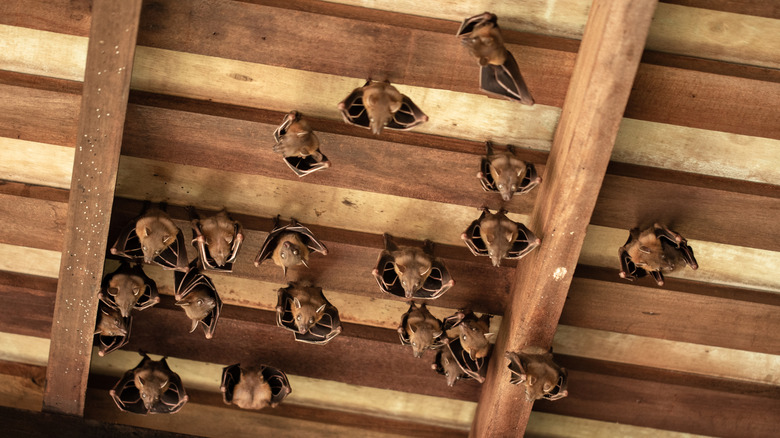Why It's Essential To Check Your Home For Bats In The Spring
While bats often conjure up fear, they actually play an indispensable role in our ecosystem, helping with everything from pest control to plant pollination. However, while building a bat house in your garden might be the mosquito solution of your dreams, having them in your home can quickly become a nightmare. In addition to potentially having rabies, bats can also cause structural damage and attract bugs and mites into your house. Most concerning, though, is the fact that their droppings, which contain fungal spores, can turn to "dust" when disturbed and become airborne. This means that anyone in the home may be inhaling the pathogens and can become seriously ill.
All of these factors make checking for bats essential, especially in the spring because, as the warmer months begin, bats become more active. Around April, they tend to either wake up from hibernation or return from migration. Spring is also the time when bats begin looking for safe spots to have and raise babies, making them particularly interested in cozy attics.
That being said, simply peeking into your attic is not enough. Unlike in the movies, bats won't necessarily be hanging from the ceiling. What's more, they can also set up a temporary home between your walls. Instead, it's best to look for a number of other telltale signs to confirm their presence, then take the right steps to ensure they are removed safely and never come back. Here's everything you need to know.
How to check your home for the presence of bats
If you suspect that bats may be sharing your personal space, a number of factors can quickly confirm their presence. Telltale signs include the sound of screeching or scratching (particularly at night or early in the morning), the smell of ammonia, or the presence of bat droppings. Also called guano, these droppings look like small, dark pellets and quickly become dry as dust. Bats leave behind a lot of guano, so you may even be able to notice it outside your home, namely on your porch or window sills. If the bats have been present for a longer period of time, you may also spot brown stains next to the opening they're using to gain entry. These markings are left by the bat's oily fur as it repeatedly squeezes in and out.
It's important to note that bats will not damage your home to get inside. Rather, they will use existing shortfalls to their advantage. Indeed, a quarter-inch hole or crack is all that's needed for a bat to wiggle their way into your house. Look closely for holes in the walls, roof shingles that are damaged, and gaps in door and window frames. The presence of such gaps will help confirm whether or not bats would be able to access your house.
How to get rid of bats and protect your home the right way
Once you've confirmed their presence, there are a number of ways to get rid of bats in your attic. However, the most important thing to keep in mind is that these flying mammals are endangered and most bat species are protected by law, either at the state or federal level, or both. That means that handling them incorrectly can lead to fines and penalties, even if they've shacked up inside your house.
While you can try to remove them yourself, the best course of action is to contact a local wildlife removal expert or go through your state department of natural resources to find a qualified pro who can help. What's more, cleaning up bat droppings is also a delicate procedure. Do not sweep or vacuum it, as this can make it airborne and a larger health hazard. Instead, contact a guano removal expert to get the job done without any harm to you.
Next, it's time to ensure the bats don't ever want to come back. Keep bats away from your home with cinnamon by mixing it with a few cups of water and spraying it around your attic. Additionally, use bat covers on vents and chimneys, and patch up any holes that may be used as entrances. Use caulking to fill in gaps around window and door frames, replace broken roof shingles, and patch up all openings on the outside of your home so that there is no space for bats to wiggle through.


